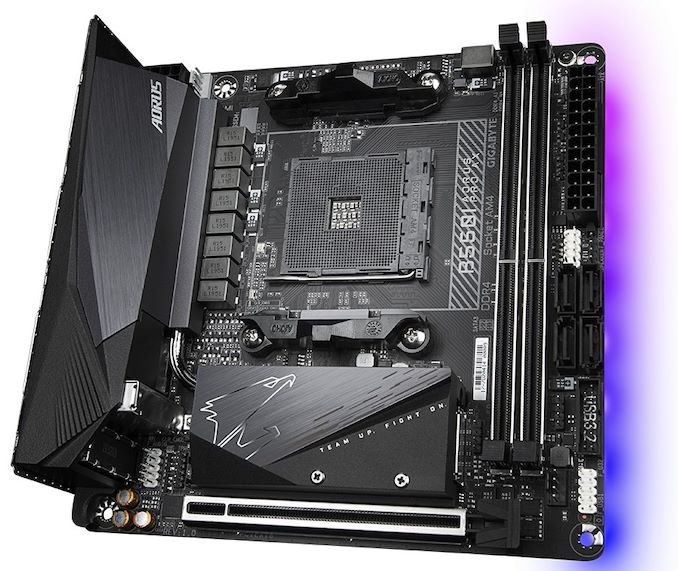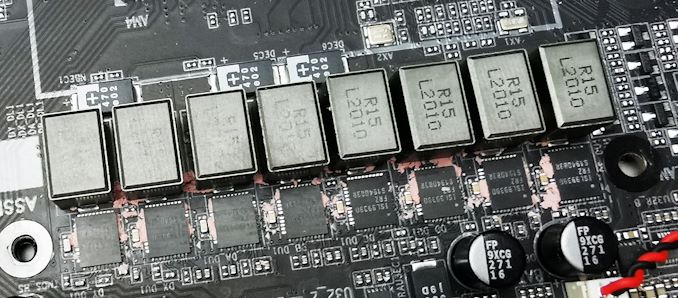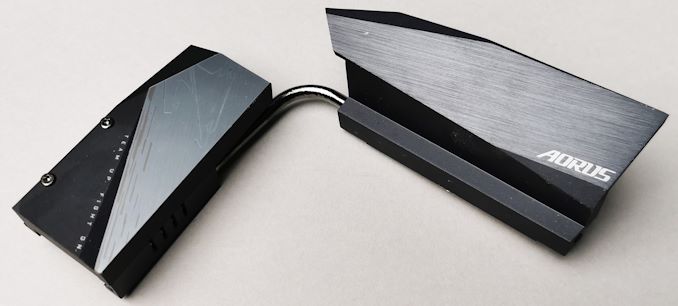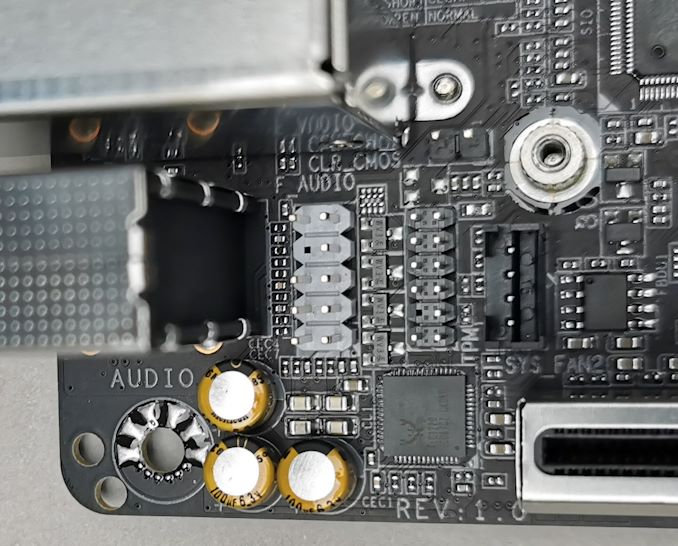The GIGABYTE B550I Aorus Pro AX Motherboard Review: All The Small Things
by Gavin Bonshor on December 7, 2020 10:00 AM ESTVisual Inspection
Looking very closely at the GIGABYTE B550I Aorus Pro AX motherboard, it has a small but capable frame with a very neutral aesthetic. It employs a primarily black and grey design, with a silver combined chipset and front-mounted M.2 heatsink, with one section of RGB LED lighting, which lights up the board's underside along the right. For users looking to add a little more pizazz, GIGABYTE includes an addressable and regular RGB LED strip pairing compatible with a lot of different RGB ecosystems, including Corsair's iCUE and NZXT CAM. However, GIGABYTE has its own called RGB Fusion 2.0.
Despite being mini-ITX, the GIGABYTE B550I Aorus Pro AX has plenty to focus on. Looking at expansion support, there is a single full-length PCIe 4.0 x16 slot, with the capability to install up to one PCIe 4.0 x4 M.2 slot on the front of the board, with a second slot on the rear of the PCB with support for both PCIe 3.0 x4 and SATA drives. There are four SATA ports for SATA devices, which are all straight angled and sit directly below the 24-pin ATX 12 V power input. These SATA ports do include support for RAID 0, 1, and 10 arrays, and they don't share bandwidth with any of the M.2 slots, even when SATA based M.2 drives are installed.
Users familiar with the mini-ITX form factor can appreciate that there will be limitations in connectivity, both internal and external. One of these is prevalent in its support for cooling, with just three 4-pin fan headers available on the B550I Aorus Pro AX model. One of these is dedicated to a CPU fan, while the other two are for chassis fans, although AIO pumps are supported through all three headers.
Memory compatibility looks strong with GIGABYTE's official support for up to DDR4-5100 memory, with a total capacity of up to 64 GB. Both of the memory slots and the full-length PCIe 4.0 x16 slot come with PCIe armor, designed to reinforce the slot to avoid physical damage to the slots when installing hardware. This also gives the slots better structure for heavier components such as NVIDIA's latest RTX 3090 graphics card, which is notoriously large and bulky.
For the power delivery, GIGABYTE is using an 8-phase design, which is being controlled by a Renesas RAA229004 PWM controller. The configuration is split into a 6+2 configuration, with six premium Intersil ISL99390 90 A power stages for the CPU and two ISL99390 90 A power stages for the SoC. On paper, this is one of the most capable mini-ITX models from the B550 models in regards to maximum power output to the CPU, with a maximum output of up to 540 A for the CPU. Delivering power to the CPU is a single 8-pin 12V ATX power connector.
The power delivery heatsink is interconnected to the M.2 and chipset heatsink, a common theme on mini-ITX models. It doesn't include finned heatsinks, so it relies primarily on mass, although the heatsink's top will catch airflow within a chassis. Unlike the X570 variant, there is no cooling fan above the chipset heatsink, which is a plus as it should be more than adequate without one.
The GIGABYTE B550I Aorus Pro AX is using a simplistic yet premium audio setup. It includes three Japanese Nichicon gold audio capacitors, with the driving being done by a Realtek ALC1220-VB HD audio codec. This is cramped in directly next to the end of the full-length PCIe slot, with no EMI shielding and no visible audio PCB segregation. There is also a front panel audio header, which is also powered by the ALC1220HD codec, although it is in this funny little position. This might interfere with the backplates on some of the larger graphics cards.
For a small board such as this one, it has an acceptable amount of connectivity on the rear panel, which is largely down to space restrictions. Starting with USB, the B550I Aorus Pro AX makes use of two USB 3.2 G2 ports, one Type-A, and one Type-C, with four additional USB 3.2 G1 Type-A ports. While this in itself isn't a lot, GIGABYTE does include a USB 3.2 G1 and USB 2.0 front panel heading pairing, which each allows a further four ports (two each) to be added to the system. The networking configuration is premium, with a Realtek RTL8125 2.5 GbE port, with two antenna ports for the Intel AX200 interface with Wi-Fi 6 and BT 5.0 support. Three 3.5 mm audio jacks are driven by a Realtek ALC1220-VB HD audio codec, while a trifecta of video outputs consisting of two HDMI 2.1 and a DisplayPort allows users to utilize the Ryzen 4000 APU's. Finishing off the rear panel is a Q-Flash Plus button.
















76 Comments
View All Comments
quorm - Monday, December 7, 2020 - link
What is the massive AMD AM4 keep out area?Slash3 - Monday, December 7, 2020 - link
The space around the CPU socket required for mounting clearance is probably what they're referring to. On that note, the Asrock AM4 mITX actually use Intel LGA11XX mount spacing for this reason.meacupla - Tuesday, December 8, 2020 - link
The AM4 keepout area is a good thing though. Especially when the mobo adheres with the steel backplate.There are plenty of LGA11XX mITX boards that completely ignore the back side of the MOBO and run into issues with aftermarket CPU coolers that require backplates.
Allan_Hundeboll - Thursday, December 17, 2020 - link
I "upgraded" from ab350 fata1ity to the b550i Aorus pro because I wanted a board that would support ryzen 5000. I also hoped the better vrm would make it possible to oc my water-cooled 3700x a little higher.But the the b550I seems to hate my 2x16GB micron rev E memory. So I just can't make 1900Mhz IF/3800Mhz MEM stable like it did on the cheap ab350.
The strong VRM didn't oc my 3700x any better, but I discovered that low PBO power draw values (like 5W) makes. PBO boost like crazy, when disabling C3 sleep. So my cpu benchmarks gained a little performance.
So you made a smart decision holding on to that ab350!
Mr Perfect - Monday, December 7, 2020 - link
The lack of USB ports is odd, especially when they included three video ports that a majority of people will never use. If AMD CPUs had built in video ports, then sure, throw in a whole bunch of graphics ports, but a gaming board isn't likely to get an APU installed.calc76 - Monday, December 7, 2020 - link
The B550 chipset is the limiting factor with USB 3 ports. The B550 isn't really in the same class chipset as a Z490. The B550 supports more ports than are in some of the mini-ITX boards but ones like the ASUS B550-I support nearly all but some of the extra USB 2.0 ports.mkarwin - Tuesday, December 15, 2020 - link
Even with USB3 count restriction, there are still USB2 options - most printers/keyboards/mice/scanners won't need the gen 3 speeds so adding a quartet of additional rear I/O placed USB2 ports wouldn't break the bank whilst giving a lot more connectivity that people could actually use... Though at the same time, X570 boards from the same product family are not fairing any better whilst being "top of the line AM4 chipsets" sporting. Somehow the ATX size allows adding more ports to the rear I/O, but already mATX suffers nearly the same as mITX. I'm not sure if those ATX offerings come with additional USB controllers on board that just can't fit on ITX boards or maybe it's merely manufacturers way to skimp $1 on a set of connectors on the back and treat it as an excude for no additonal signaling work through the PCB whilst still asking higher prices for the premium smaller market...Luminar - Monday, December 7, 2020 - link
Just what we need instead of a 6800 review lolGolgatha777 - Monday, December 7, 2020 - link
True, you can actually buy this.vanilla_gorilla - Monday, December 7, 2020 - link
This is exactly what I need. I'm currently using an X570 I Aorus Wi-Fi mini-itx board in a SFF case. The problem is I cannot find any AM4 Mini-iTX boards with multi-gig or 10GbE LoM. I'm really disappointed we don't see more multi and 10Gb boards. I just got an email last week that Google Fiber now offers 2Gb/s service here in Nashville. I was looking at USB based multi-gig adapters but I'd much rather have it on the motherboard, of course.